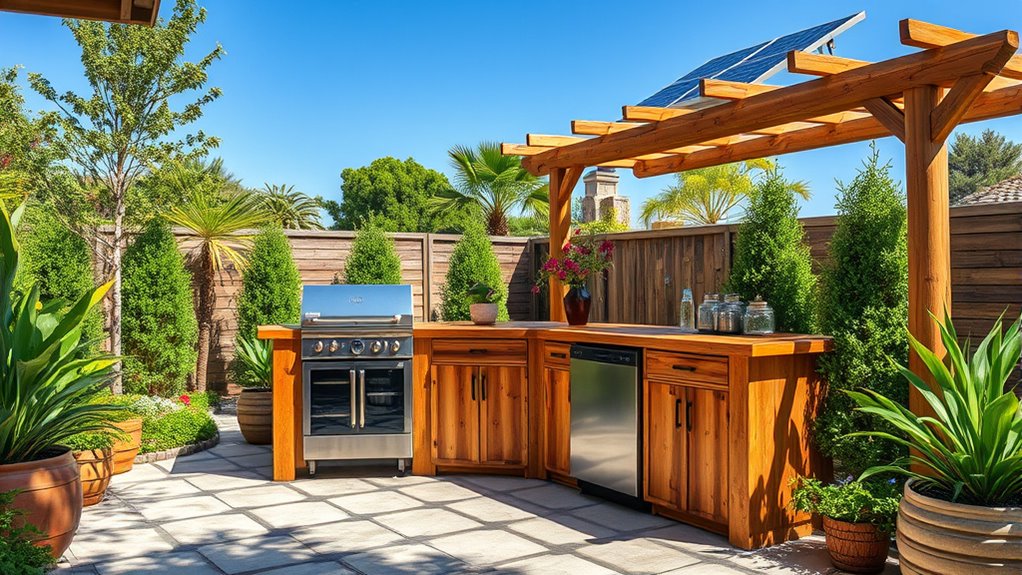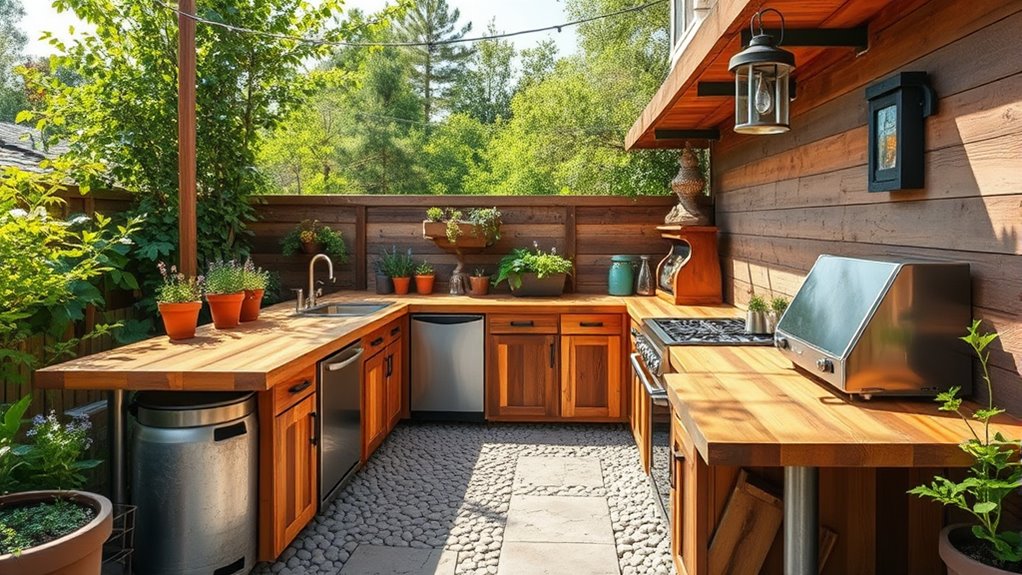To create a sustainable outdoor kitchen, choose eco-friendly materials like reclaimed wood, recycled metal, and native plants that thrive locally. Incorporate solar-powered appliances, energy-efficient lighting, and rainwater harvesting systems to reduce your environmental footprint. Prioritize durable, weather-resistant designs to minimize replacements. Combining these practices results in a stylish, eco-conscious space that’s kinder to the planet. Keep exploring to discover more ways to enhance your outdoor kitchen sustainably.
Key Takeaways
- Incorporate reclaimed wood, recycled metal, and salvaged stone for countertops and furniture to reduce waste and environmental impact.
- Use native, drought-tolerant plants to create sustainable landscaping that requires less water and supports local ecosystems.
- Install solar-powered appliances and outdoor lighting to cut energy consumption and lower carbon footprints.
- Implement rainwater harvesting systems for outdoor cleaning, watering, and dishwashing needs.
- Design with durable, weather-resistant materials to ensure longevity and minimize the need for frequent repairs or replacements.

Ever wondered how to create an outdoor kitchen that’s both stylish and eco-friendly? It’s easier than you might think. The key is choosing sustainable materials and practices that minimize your environmental impact while still offering a beautiful, functional space. One of the best ways to embrace eco-friendliness is by incorporating solar powered appliances. These devices use renewable energy from the sun, reducing reliance on traditional electricity sources and lowering your carbon footprint. From solar-powered grills to outdoor lights, these appliances can seamlessly integrate into your kitchen, providing convenience without sacrificing sustainability. Not only do they save energy, but they also cut down on electricity bills, making your outdoor space more economical in the long run.
Create an eco-friendly outdoor kitchen with solar appliances, sustainable materials, and native plants for a stylish, green space.
Alongside solar technology, native plant landscaping plays a vital role in creating an eco-friendly outdoor kitchen. Native plants are adapted to your local climate, requiring less water, fertilizers, and pesticides. By designing your landscaping with these plants, you promote biodiversity and support local ecosystems. They also add a natural, vibrant aesthetic that enhances your outdoor environment. Consider planting drought-tolerant grasses, flowering perennials, and shrubs that thrive naturally in your area. This approach minimizes resource use and maintenance, making your outdoor kitchen more sustainable and easier to care for. Plus, native plants attract beneficial insects and pollinators, which help keep your garden healthy and productive. Incorporating sustainable gardening practices further enhances your eco-friendly setup by conserving resources and supporting the environment.
When planning your outdoor kitchen, think about using recycled or reclaimed materials for countertops, cabinetry, and furniture. Reclaimed wood, recycled metal, and salvaged stone not only add character and charm but also reduce waste. These materials often have a lower environmental impact than new products, supporting a circular economy and conserving resources. Additionally, incorporating rainwater harvesting systems can further enhance your eco-friendly setup. Collecting rainwater for cleaning, watering plants, or even washing dishes reduces dependence on municipal water supplies and helps manage runoff.
Lighting your outdoor space with LED fixtures or solar-powered lights is another simple yet effective practice. These options consume less energy and are longer-lasting, aligning with your goal of sustainability. When designing your outdoor kitchen, prioritize durability and weather-resistant materials to guarantee your investment stands the test of time, reducing the need for frequent replacements. Overall, blending solar powered appliances, native plant landscaping, and eco-conscious materials creates a seamless, sustainable outdoor kitchen that’s both beautiful and environmentally responsible. With thoughtful planning and mindful choices, you can enjoy an outdoor space that’s kind to the planet and perfect for gathering with friends and family.
Frequently Asked Questions
How Do Sustainable Outdoor Kitchens Impact Home Value?
A sustainable outdoor kitchen can boost your home resale value and market appeal. When you invest in eco-friendly materials and practices, you make your property more attractive to environmentally conscious buyers. This upgrade not only enhances your outdoor space but also signals quality and sustainability, making your home stand out in the market. Ultimately, a well-designed, eco-friendly outdoor kitchen can lead to higher offers and quicker sales.
Are Eco-Friendly Materials Cost-Effective Long-Term?
Think of eco-friendly materials as planting a tree—initially, it might seem costly, but over time, the benefits grow. You’ll find that the cost comparison favors these materials when considering their durability and low maintenance. They withstand the elements better, reducing repair costs. So, yes, eco-friendly materials are cost-effective long-term, offering you savings and sustainability, much like nurturing a tree that provides shade and fruit for years to come.
What Maintenance Is Required for Eco-Friendly Outdoor Kitchen Materials?
You’ll need to perform regular cleaning routines to keep eco-friendly outdoor kitchen materials in top shape, using gentle cleaners suitable for the specific surface. Additionally, conduct periodic material inspections to spot any signs of wear or damage early. This proactive maintenance helps prolong their lifespan, keeps your kitchen looking great, and guarantees eco-friendly materials continue to function efficiently. Consistent care minimizes costly repairs and maintains your outdoor kitchen’s sustainability benefits.
Can Sustainable Kitchens Be Customized for Different Climates?
You can absolutely customize sustainable kitchens for different climates. Imagine a cozy, insulated space for chilly winters or a breezy, open setup for summer’s heat. By using climate-specific design and adaptable material choices, you guarantee durability and comfort year-round. Whether it’s rust-resistant metals for humid areas or insulated panels for colder zones, your eco-friendly outdoor kitchen can seamlessly blend functionality with environmental consciousness, tailored perfectly to your climate.
How Do Eco Practices in Outdoor Kitchens Reduce Overall Environmental Footprint?
Eco practices in outdoor kitchens help reduce your environmental footprint by promoting energy conservation and habitat preservation. Using energy-efficient appliances and sustainable materials lowers energy consumption, while choosing locally sourced, eco-friendly products minimizes habitat disruption. These practices also encourage responsible resource use, ensuring that natural landscapes remain intact and healthy. By adopting eco-friendly methods, you actively contribute to a greener environment, making your outdoor kitchen both stylish and sustainable.
Conclusion
By choosing eco-friendly materials and sustainable practices, you’re not just building an outdoor kitchen—you’re protecting the planet for future generations. Remember, a wise person once said, “The earth doesn’t belong to us; we belong to the earth.” So, embrace green building methods, minimize waste, and use renewable resources. Your outdoor space can be beautiful and sustainable—proof that small changes can make a big difference. Start today and make every meal a step toward a healthier planet.









